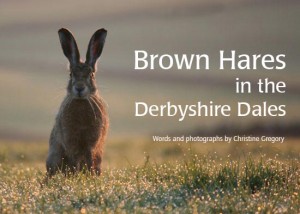Christine has lived in the Derbyshire Dales for 22 years and has made a very detailed study of the brown hares in the region.
Hares were introduced into this country by the Celts about 2000 years ago for both religious reasons and food. Down the years they have been associated with most religions and even witchcraft. There are three types of hare that live in the British Isles, the mountain hare, the Irish hare and the brown hare. The mountain hare and the brown hare live in Derbyshire. In winter the mountain hare changes its coat and becomes white making it hard to spot in snowy conditions but the brown hare does not.
As its name suggests it has a very colourful brown coat, long pointed ears which are tipped with black and are white at the back. It has bright brown eyes and a black tail which it holds down when in flight. Unlike its smaller cousin, the rabbit, it lives above ground and almost from birth lives alone. As soon as a doe gives birth to a litter she takes each leveret (baby hare) to a different part of the area for it to grow up. The leveret knows that this is its territory and once a day the doe will call it for suckling. Hares do not have a home but they do have a territory.
Hares are herbivores and forage for food all night. Although they are not sociable animals they will congregate for mating and can be seen in the mornings and evenings during the mating season which can run from March to October. During this season they can be seen running around and also standing on the hind legs boxing. The female is slightly larger than the male and it is generally the female doing the boxing to deter an amorous male. A doe will give birth to a litter, which on average consists of about 3 leverets after a 42 day gestation period, but she can have 2 or 3 litters inside her at any one time.
Its main enemies, apart from man, are the badger and the fox. In the 19th century there were about 4 million hares in the country but by the year 2000 their number had dropped dramatically to about 250,000, mainly due to man’s activities in shooting and farming: fortunately this decline is being reversed now.
The hare has almost 360o vision but does have a blind spot directly in line with its nose. It also has very powerful, long back legs and if it spots a predator from a distance it is likely to stand on these to make it look bigger and it will remain in the same place. However if it has to run to escape it will always try to run to higher ground, jumping over walls and changing direction many times to confuse and exhaust its assailant.
Christine’s talk was extremely interesting and I have barely skimmed the surface. If you would like to know more about the subject and her work she has written a book called “brown hares in the Derbyshire Dales”, available from Amazon, or you can find out more by going to her website , clickhere.
